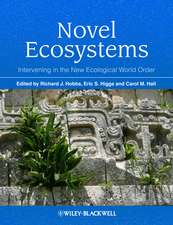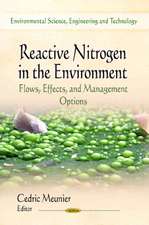Geochemistry of Organic Matter in the Ocean
Autor Evgenii A. Romankevichen Limba Engleză Paperback – 30 mai 2012
Preț: 645.79 lei
Preț vechi: 759.76 lei
-15% Nou
Puncte Express: 969
Preț estimativ în valută:
123.57€ • 129.71$ • 102.57£
123.57€ • 129.71$ • 102.57£
Carte tipărită la comandă
Livrare economică 10-24 aprilie
Preluare comenzi: 021 569.72.76
Specificații
ISBN-13: 9783642499661
ISBN-10: 364249966X
Pagini: 356
Ilustrații: XVI, 336 p. 116 illus.
Dimensiuni: 170 x 244 x 19 mm
Greutate: 0.57 kg
Ediția:Softcover reprint of the original 1st ed. 1984
Editura: Springer Berlin, Heidelberg
Colecția Springer
Locul publicării:Berlin, Heidelberg, Germany
ISBN-10: 364249966X
Pagini: 356
Ilustrații: XVI, 336 p. 116 illus.
Dimensiuni: 170 x 244 x 19 mm
Greutate: 0.57 kg
Ediția:Softcover reprint of the original 1st ed. 1984
Editura: Springer Berlin, Heidelberg
Colecția Springer
Locul publicării:Berlin, Heidelberg, Germany
Public țintă
ResearchCuprins
Abbreviations.- 1. Sources of Organic Matter in the Ocean.- 1.1 Primary Production of Organic Matter.- 1.2 Input of Allochthonous Organic Matter.- 2. Carbon of Dissolved Organic Matter in the Ocean.- 2.1 Total Quantity.- 2.2 Time of Residence.- 2.3 Distribution Patterns.- 3. Carbon of Particulate Organic Matter.- 3.1 POC Distribution from Separation Data.- 3.2 POC Distribution from Filtration and Sediment Traps Data.- 3.3 POC in Dry Matter of Suspended Material.- 3.4 Relationship Between POC and DOC.- 3.5 Living Organic Matter in Suspended Material.- 3.6 Total Quantity and Residence Time of Particulate Organic Matter in the Ocean.- 3.7 Organic Matter Morphology.- 3.8 Supply of Organic Matter in Ocean Depths and Ocean Floor.- 4. Organic Carbon in Late Quarternary Sediments of Seas and Oceans.- 4.1 Morphology of Non-Living Organic Matter in Recent Sediments.- 4.2 Principles Governing the Distribution of Organic Carbon in Bottom Sediments.- 4.3 Organic Carbon Distribution in the Size-Fractions of Sediments: Relation Between Organic Carbon and CaCO3 and SiO2(amorph).- 4.4 The Absolute Masses of Organic Carbon in the Sediments.- 5. Nitrogen and Phosphorus in the Process of Sedimentogenesis.- 5.1 Nitrogen and the Nitrogen-Carbon Ratio.- 5.2 Phosphorus and the Phosphorus-Carbon Ratio.- 5.3 Certain Features of the Cycling of Nitrogen and Phosphorus During Sedimentogenesis.- 6. Proteinaceous Compounds and Amino Acids.- 7. Carbohydrates.- 7.1 Carbohydrates in the Major Producers and Consumers of Organic Matter in the Ocean.- 7.2 Carbohydrates in Sea Waters.- 7.3 Carbohydrates in the Suspended Matter.- 7.4 Carbohydrates in Bottom Sediments.- 8. Chemical Transformations of Lipids During Sedimentogenesis.- 8.1 Lipids of Marine Organisms.- 8.2 Sea Water Lipids.- 8.3 Lipids in Suspended Material.- 8.4 Lipids in Bottom Sediments.- 8.5 Transformation of Lipids in Sedimentogenesis.- 9. Specific Organic Compounds.- 9.1 Humic Substances of Sea Water.- 9.2 Distribution of Humic Acids and Residual Organic Matter Humins in Suspended Matter and in Bottom Sediments.- 9.3 Elementary Composition.- 9.4 Molecular Weight Distribution.- 9.5 Amino Acid Composition. The Content of Carbohydrates and Functional Groups.- 9.6 The Composition of Destructive Oxidation Products.- 9.7 The Origin of Humic Acids in Bottom Sediments.- Conclusion.- References.









